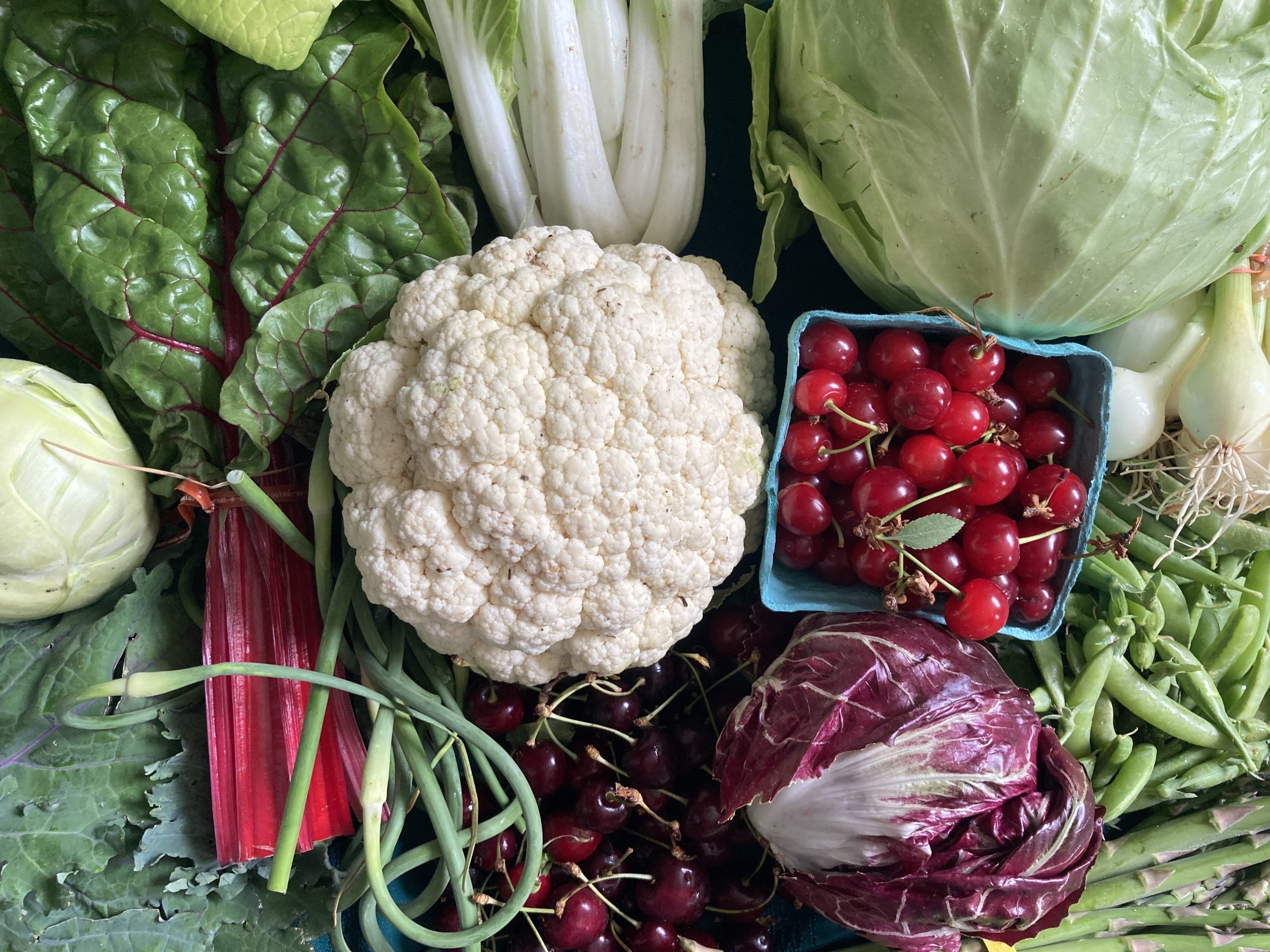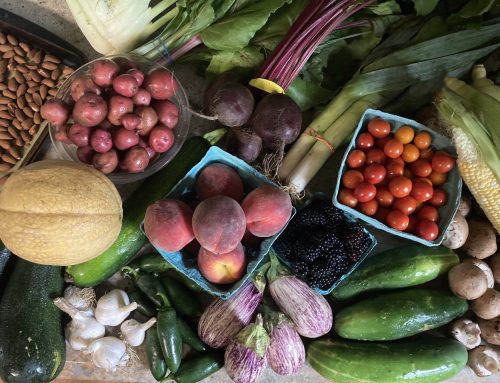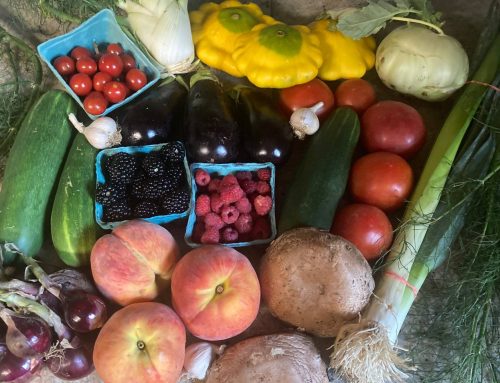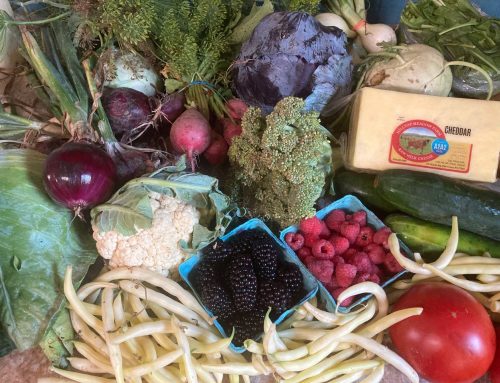Veggies We Harvested This Week: June 21, 2023
Every member’s customized Market Box is unique so we hope you will take advantage more varieties of vegetables as you get comfortable with all the great organic produce we are offering. Use our A to Z Vegetable Guide to help use and store your veggies. Storage tips and recipes below.

Farm Events:
First Ever FRIDAY Pizza Night on the Deck
Friday June 30. 5 – 8 pm.
Details Here!
Your experience includes the ambience of the farm, seating on our beautiful deck overlooking our wooded valley, watching your pizza cook in the wood fired brick oven, chatting with the farmer, optional walk on our grounds, and a visit to our artisan farm store.
We’ll provide pizza, appetizer plate, herbal teas, and water. BYOB is allowed. Other items will be available for cash purchase. Don’t miss it!
Farm Tour and Grill Out
Saturday July 1. 11 am – 3 pm.
Reuben’s Farm Tours are not to be missed. Great for children, food lovers, animal lovers, gardeners and aspiring farmers.
On this Holiday weekend, join us for the best picnic lunch you can imagine. Enjoy Grilled Grass Fed burgers, farm made brioche buns, and delicious salads on the deck either before or after your farm tour.
Mark Your Calendar for a Family Day at the Farm on Saturday July 1.
Storage & Usage Tips
As I unpack my vegetables from my market box I share extra tips and suggestions that you won’t want to miss. All the resources I mention in this video, you’ll find further below in this post.
What to use first: asparagus, broccoli, dill, lettuce, snap peas, microgreens, radish greens and cherries.
Asparagus – Store upright in a jar with an inch of water in the refrigerator. Some recommend draping a plastic bag over the spears. Best flavor if used within a couple days but will keep longer. The key to enjoying asparagus is to trim off the “woody” ends. The tough fibers are unpleasant compared to the soft, melt in your mouth stems and tips. This video (at minute 5:50) shows my preferred method. Freeze with blanching method for 30 – 60 seconds depending on thickness. This post has great ideas for using your asparagus in many ways. This recipe is perfect for this time of year: Grilled Asparagus with Spring Onion and Lemon.
Bok Choy – Bok choy can be eaten either raw or cooked. If stir frying or sautéing, chop the white stalks separately from the green leaves. Start cooking the white stalks several minutes before adding the leaves to avoid over cooking the greens.
Bok choy can also be grilled by cutting the vegetable lengthwise and drizzling with oil. Storage: Do not wash until ready to use. Store in an open plastic bag in the refrigerator crisper drawer. Dirt often gets trapped in the widest part of the white stalks, so wash it well. Try these recipes: Grilled Bok Choy & Pork Chops, Bok Choy with Chile, Garlic, and Ginger, Bok Choy and Shrimp Stir-fry
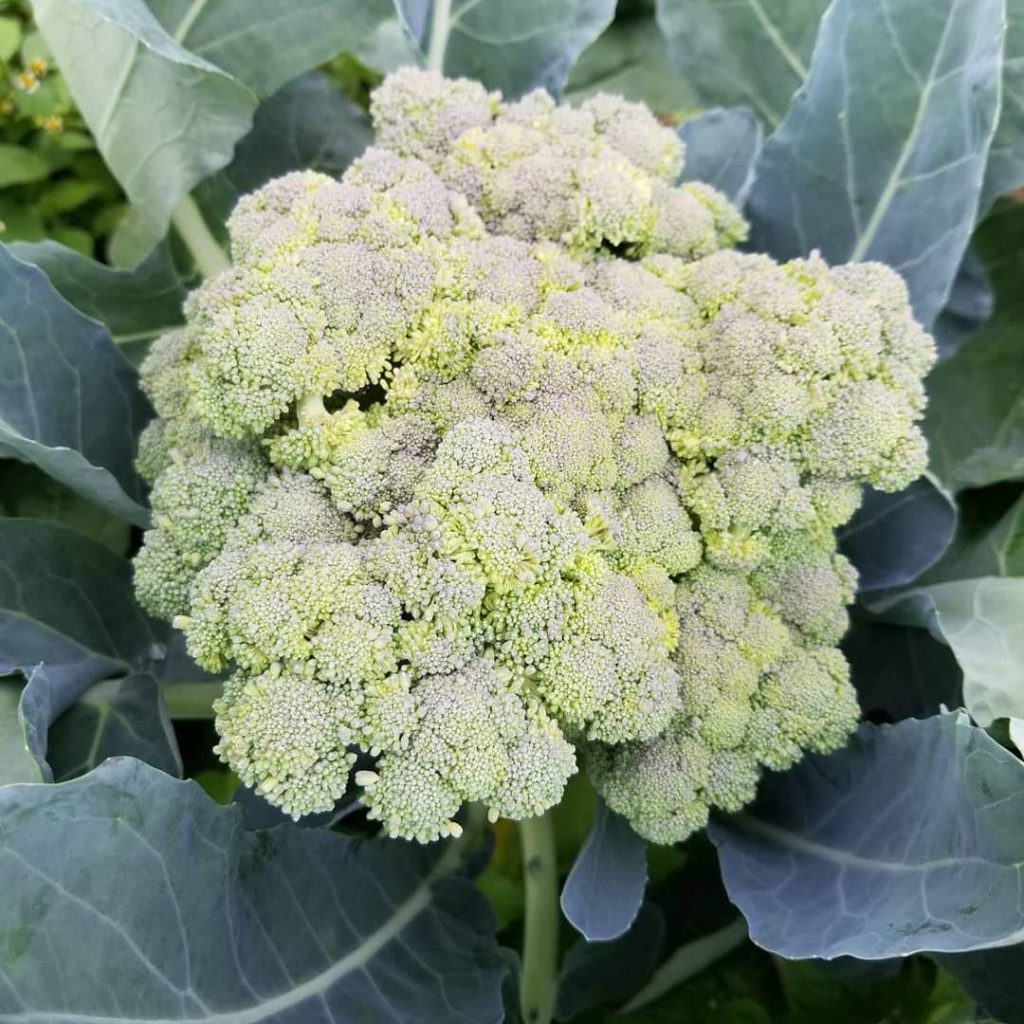
Broccoli – is a “temperamental” crop to grow successfully so we are happy to have it for you this week – Farmer Leroy does a great job! Broccoli should be kept unwashed, trimming only the large leaves (save leaves for DIY veggie stock). Stored in a perforated, plastic bag in the refrigerator, it will keep fresh for several days. To prepare, first rinse the broccoli, if necessary, soak upside down in cold, salted water. Broccoli is best when quickly steamed or stir-fried. Overcooking enhances its strong flavor and aroma, dulls the color, and leaches out nutrients. It should be cooked a minimum amount of time until tender, but still crisp. Although raw broccoli is often served as crudités with dip, a quick blanching will both tenderize and reduce the strong flavor. Broccoli will take 8-15 minutes to steam, 4-8 to blanch. Test for doneness by piercing the stalks with a knife point. The knife will pierce easily, but the broccoli should remain crunchy. If you plan to use it later, cool by plunging immediately in cold water. Drain and pat dry. Steam or blanch broccoli before sautéing or stir-frying. Store in plastic bag in the hydrator drawer of fridge and eat within a few days. Check out Stop Throwing Away Your Broccoli Stems for more ideas.
Cabbage – this is a green summer cabbage, which means that it is great for any cabbage recipe but it is not meant for long term storage like fall cabbages. It does store well wrapped in plastic in the crisper drawer or in a tightly sealed container in the refrigerator. Two recipes for coleslaw: Creamy version, vinegar version – see this post. You can also make a jar of summer sauerkraut – see below. Here is a Stir Fry Recipe to use your cabbage and peas.
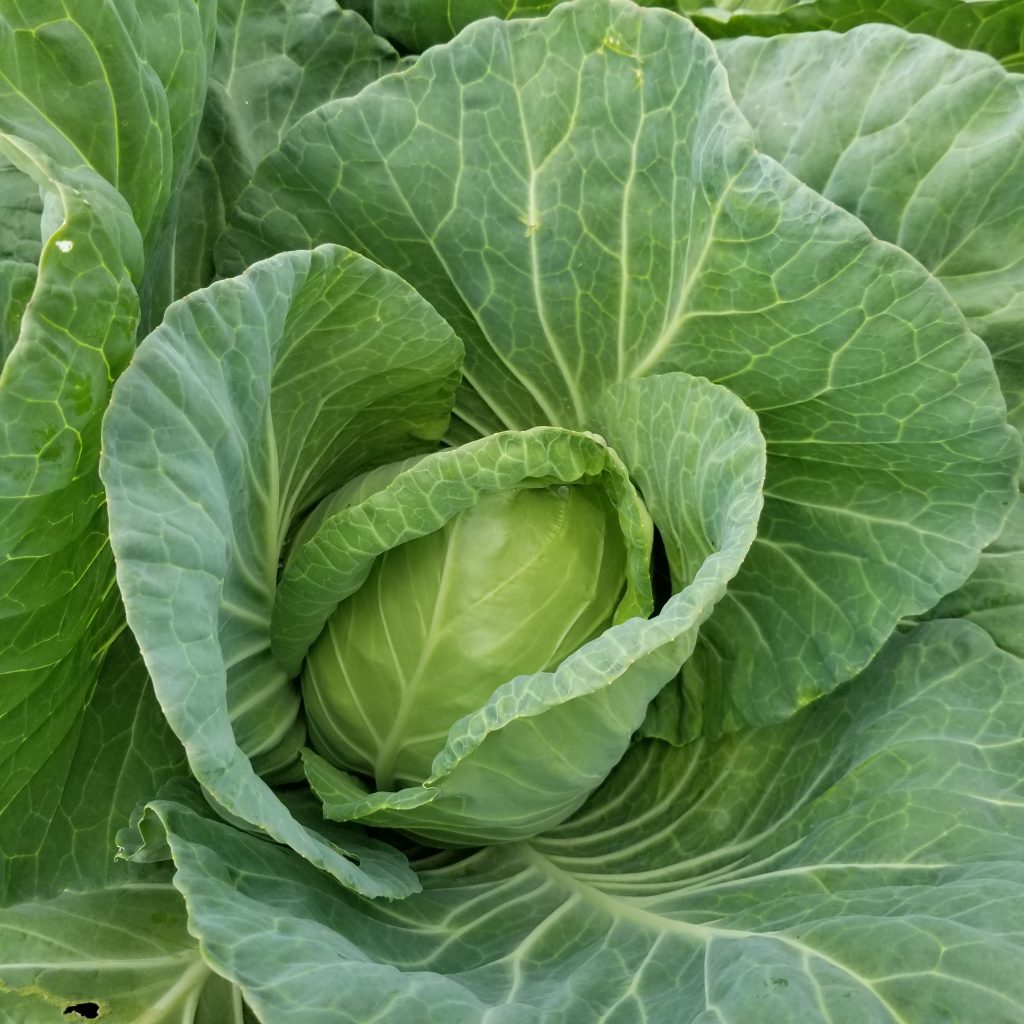
Cauliflower – can be roasted steamed, sautéed, or even enjoyed raw in salads. Use as a low-carb substitute for rice or mashed potatoes, or an ingredient in soups, stir-fries, and as a pizza crust alternative. Store cauliflower in a plastic bag or airtight container in the refrigerator. Whole heads can last up to a week, while cut or florets should be used within 2-3 days for optimal freshness. Ensure it is dry and not exposed to excess moisture to avoid spoilage. ROASTED cauliflower turned my family into cauliflower LOVERS, rather than haters. This is a favorite recipe: Roasted Cauliflower with Pasta and Lemon Zest. I even make this recipe without the pasta.
Chinese/Napa Cabbage – Can be eaten raw in salads or cooked any way you would use traditional cabbage. It tastes excellent in Asian-flavored dishes, especially stir frys. Stir fried Chinese Cabbage Recipe Store the napa cabbage wrapped in a damp towel or plastic bag in crisper drawer. The napa cabbage will stay fresh for up to two weeks. Try this Napa Cabbage Salad.
Collard Greens – To store, wrap the greens, unwashed, in damp paper towels until you are ready to use them. Keep the wrapped greens in an open plastic bag in the refrigerator for up to about 5 days. When you are ready to cook the greens, you’ll need to wash them. To freeze: Wash the leaves, cut off the woody stems, blanch in boiling water for three minutes and chill in ice water. Dry the leaves, pack into freezer bags and freeze. Recipes: Sautéed Collard Greens, Collard Green and Basil Pesto: Two Versions
Dill – like all herbs, will not last long once picked. Place upright in a glass of water in the fridge or on your kitchen counter. Dill pairs well with potatoes, cucumbers, and green beans. If you cannot use the dill this week, preserve the herb by tying a string around the bunch and hanging it upside down in a well-ventilated and dry area. When it’s dry, crumble and store in an airtight container. Making a dill dressing to use on salad, dip, grilled veggies or meats also preserves the dill longer.
Garlic Scapes – Your second week (and maybe last) of this CSA specialty. They keep well for a long time in a plastic bag in the refrigerator but don’t forget about them. Use them for their mild garlic flavor in anything you would use garlic, chives or scallions. Use them cooked, raw or pickled. Here are 10 ideas. Place in a plastic bag in fridge for two to three weeks. It makes a delicious pesto. Simply replace basil with garlic scapes in a pesto recipe. This pesto may also be frozen flat in a plastic bag so that you may break off a chunk as needed. Garlic Scape Pesto. If you can’t get through them fast enough, just chop them up and throw them into the freezer in a Ziploc freezer bag. Use them all winter long as a garlic substitute. I like to use these in garlic-scape compound butter or add to my own DIY cream cheese.
Kale – Lacinato or Red Russian kale. Store in a loosely sealed plastic bag in the crisper drawer for 7-10 days. Lacinato is dark green, narrow bumpy leaves. Red Russian kale has red/purple stems and a more tender, flatter leaf. To freeze, wash and chop into small pieces and place in a freezer bag. This would be delicious used in the winter in a potato soup or vegetable stir fry. I love it sauteed with garlic and olive oil until bright green and tender. Add Kielbasa to your cart and try this Kale and Kielbasa Soup.
Kohlrabi – green or purple variety. Cut off leaves and store separately in a plastic bag – you can use them like kale! Most likely you will receive purple kohlrabi which is more often used as a cooked vegetable. Green varieties are very suitable raw and may be cooked as well. Store bulbs in a bag or wrap in a moist paper towel. Both parts should be stored in the vegetable drawer of the refrigerator. This post has great info and suggestions for Kohlrabi. Other CSA members have enjoyed their kohlrabi grilled, roasted and spiralized into noodles. See below for a kohlrabi salad recipe.
Loose Leaf Lettuce – this variety is a cut leaf lettuce. Store it properly to last all week. How to Store Lettuce. Try a DIY Salad Dressing – see below.
Microgreens – Refrigerate immediately. Keep bag sealed. Fold down to remove most air. Put in coldest part of refrigerator. Often, a bottom shelf. Can be frozen to add later to soups and other meals. Check out Emanuel Farm Powdered Microgreens for longer term shelf life. They are a tasty, nutrient-rich boost for shakes, smoothies and meals and a great seasoning for adding flavor to dishes and dips. All our micro greens are from Emanuel Farms. I love putting microgreens on my egg and cheese english muffin sandwiches.
Mushroom, Portobello & Cremini – These two mushrooms are the same variety but are harvested at different sizes. Store in a paper bag and refrigerate in the main section of the fridge with a dry paper towel to absorb excess moisture. Alternatively, mushrooms can be briefly sautéed or blanched before freezing to extend their shelf life for up to 3 months. See below for E-book.
Radish – the roots keep well for up to two week in a plastic bag in the fridge. Remove leaves if they are still attached. Store the unwashed greens in a loosely wrapped Debbie Meyer plastic green bag in the crisper bin of your refrigerator and eat them ASAP. Store the radish roots dry and unwashed in a plastic bag in the refrigerator for 1 week.This root vegetable can be eaten raw or steamed for 8-12 minutes for a milder taste. I like to roast these with other root vegetables in some olive oil at 400 F until soft! They’re also good on the veggie tray with some dip. Use the greens in Radish Leaf Pesto. Try Creamy Radish Soup, Radish Spread. And if you haven’t tried pickled radishes, they will blow your mind. Use the Fermented Vegetable Recipe included in the DIY Basic Sauerkraut Formula – download to make your own pickled radishes.
Rhubarb – To store rhubarb, remove any leaves and trim the ends, then place the stalks in a plastic bag and store them in the refrigerator for up to a week. For usage, rhubarb can be cooked into compotes, jams, pies, or used in baked goods, providing a tart flavor that pairs well with sweet ingredients like strawberries or apples. Try making this Rhubarb Sauce or this pie version of a rhubarb crisp – Rhubarb Oatmeal Pie. Make your own strawberry rhubarb preserves or add our Willow Haven Preserves to your Market Box next week.
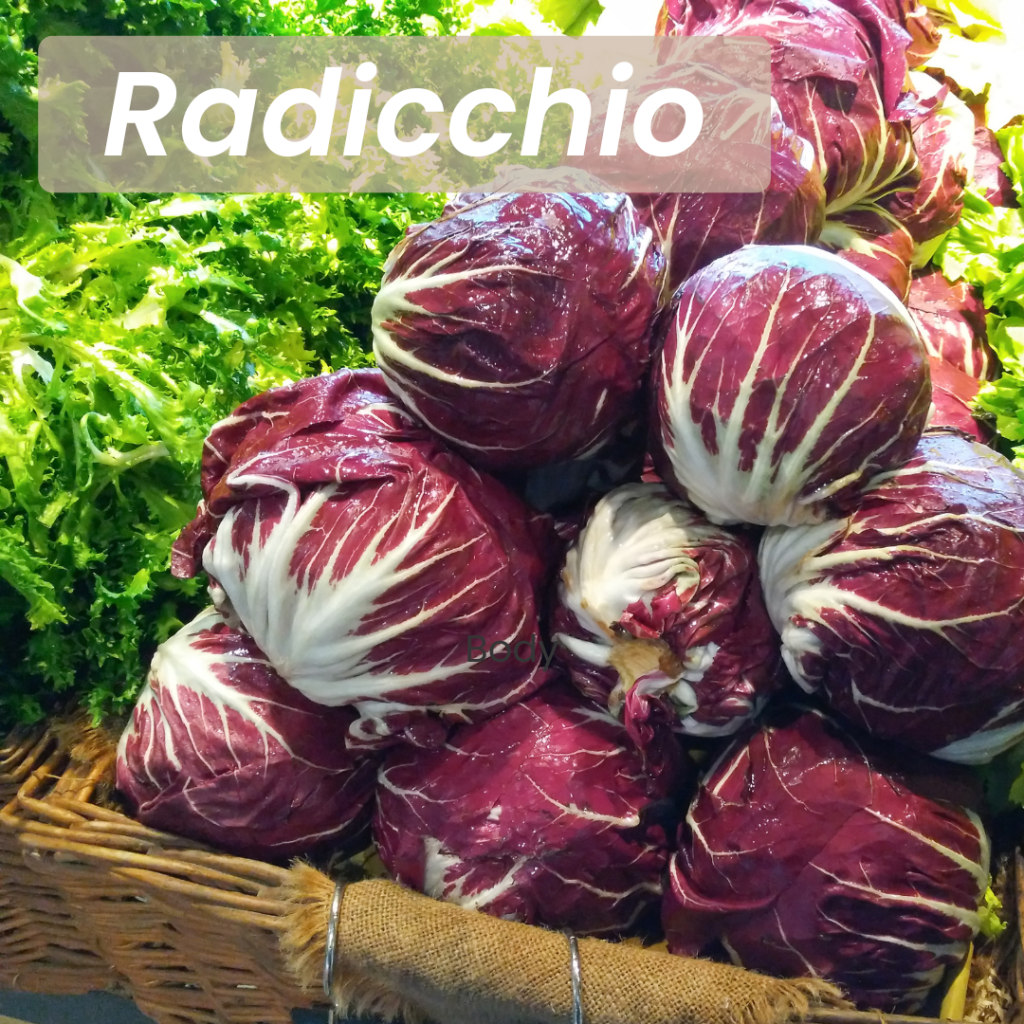
Radicchio – Radicchio is a bitter leafy vegetable with vibrant red or purple leaves used in salads and cooked dishes, offering a unique and robust flavor. To store radicchio, remove damaged leaves and keep it unwashed. Wrap it in a slightly damp paper towel, place it in a plastic bag or container, and store it in the refrigerator’s crisper drawer for up to a week. Use radicchio in salads to add a refreshing bitterness or grill and roast it to mellow the flavor for sides, sandwiches, and wraps. Sauté radicchio with garlic and olive oil for a delicious side dish or pasta and risotto topping. Add radicchio towards the end of cooking to preserve its crunch and vibrant color, being mindful of its strong flavor when pairing it with other ingredients. Enjoy the distinct taste and texture of radicchio in various culinary creations by storing it properly and incorporating it creatively into your dishes. This post will teach you how and why to use radicchio. These recipes will inspire you to cook something delicious.
Scallions – Green onions, or scallions, can be wrapped in damp towel or placed in plastic bag in the crisper drawer of the fridge. Chop and use raw or cooked anyway you would use a bulb onion. The whole of the green onion can be eaten, stalks and all.
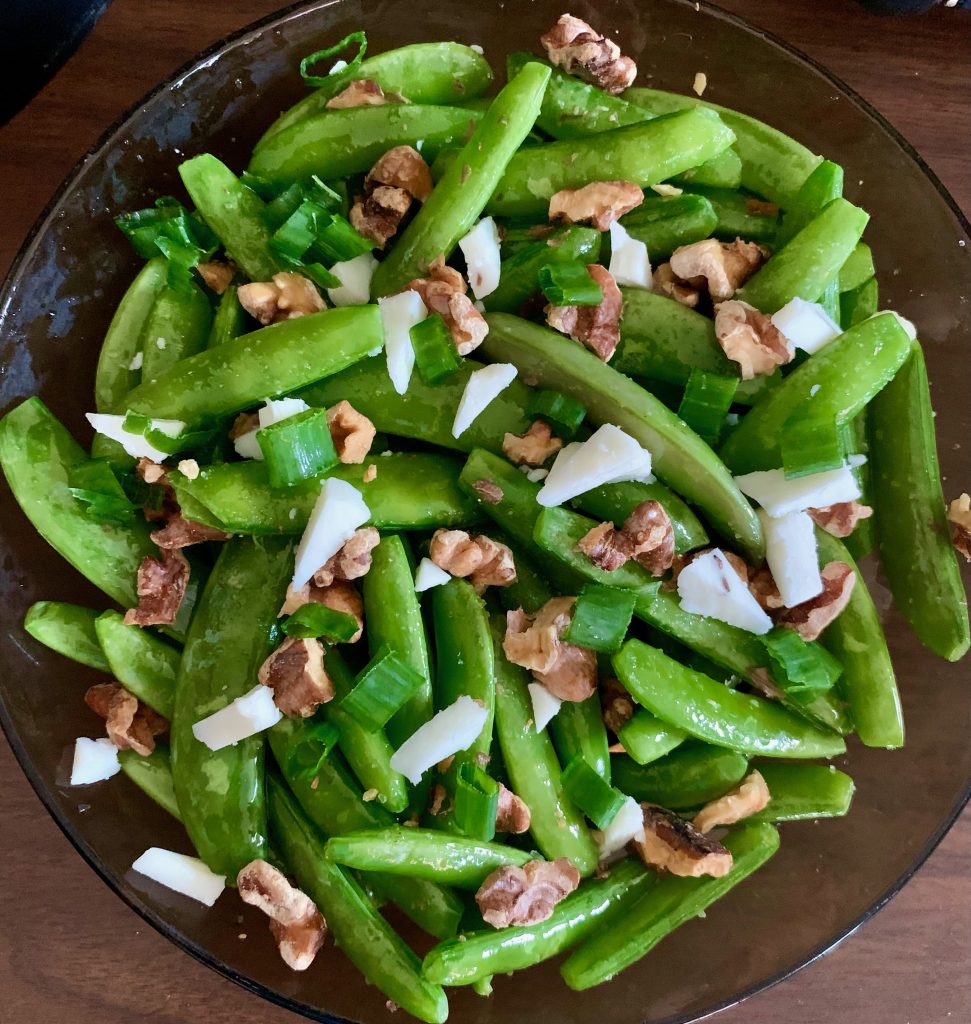
~Farm member and van driver, Jennifer, RAVED about the Truffle Bag Goat cheese she added to this Snap Pea Salad.
Snap Peas – can be enjoyed raw in salads or stir-fried for a crunchy texture. They are a versatile vegetable that pairs well with various dishes and cuisines. Store snow peas in a perforated plastic bag or breathable container in the refrigerator’s crisper drawer for up to 3-4 days to maintain their freshness and crispness. Snow Peas and Garlic is a great way to use your garlic scapes and scallions with your peas – you can use snap peas instead of snow peas. Here is a Stir Fry Recipe to use your cabbage and peas.
Swiss Chard – Chard is in the chenopod family which includes beets and spinach. The stems come in a variety of vibrant colors or simply a whitish green. Both the leaves and the stalks are edible. When cooked, swiss chard is a very good source of vitamin A, C, K, iron, and potassium. Serving Suggestions: When picked very young, chard can be part of a green salad. But full grown chard like in your box today has a very strong flavor and tough stems when eaten raw. Chard can be sliced and chopped and added to soups. After cooking for several minutes, it can also be added to rice and beans or omelets. Basically any way you would prepare spinach, you could substitute chard allowing for longer cook time for the stems. Store in a loosely sealed plastic bag in the fridge for 3-5 days. Before using, wash well in cool water and separate the leaves from the stems. See below for E-book with recipes. This is one of our family favorites Baked Swiss Chard Stems. Try this twist on bruschetta: Skillet Bruschetta with Beans and Greens.
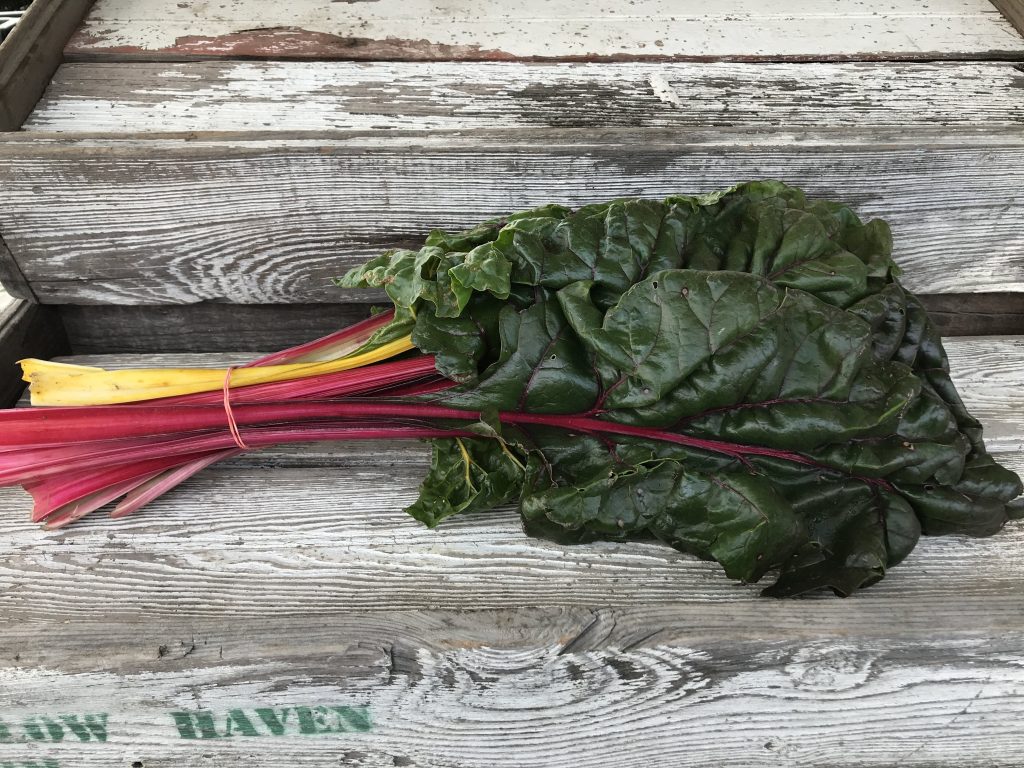
Sauerkraut: easy and delicious
Your first cabbage of the season might be the perfect opportunity to make your first fermented food. It’s a great way to start adding into your diet the super nutrients produced: live enzymes and beneficial bacteria.
This Formula for Basic Sauerkraut walks you visually through each simple step. You’ll see that carrot and garlic are added in this method but you can certainly skip them. The most basic sauerkraut is just cabbage and salt. If you have a warm kitchen, it may ferment in as little as 3 days, so don’t be shy about tasting it. Once you like the taste, after 5 – 10 days, place in the refrigerator to slow down the fermentation and keep for months. But you should eat a little every day, like a condiment to compliment your other dishes. It goes especially well with lentils, as well as the familiar sausage and potato preparations.
DIY Basic Sauerkraut Formula – download – with additional recipes for other ferments.
Have you made Green Cubes yet?
Swiss Chard, Lettuce, Bok Choy, Napa Cabbage, Green Cabbage, Collards, Kale – they are all green and leafy. PLUS, you get the bonus greens from the tops of the beets, radish and kohlrabi.
Besides throwing the stems, ends or cores of these nutritious greens in your “veggie scrap bag” for your own DIY veggie broth, you can also make “green cubes” to use later.
When you need a quick way to use your greens and get them out of your refrigerator before they go to waste, or before your next Market Box full of farm goodness arrives, the Green Cube Strategy comes to the rescue.
Making ice cube shaped pureed greens is a great way to “hide” extra nutrition into your soups, stews and sauces this winter. Leafy greens lose a lot of volume when you cook them so they are easy to store in the freezer without taking up freezer space.
How to Make Green Cubes Video: This video tutorial from my friend’s CSA farm in Ohio teaches you this quick, easy method. It may look like a number of steps but each one only takes a minute or two. You’ll be happy you saved them to use later.
Download the Green Cube Method guide to keep as a reference. Maybe even start a binder and keep these handy guides as print outs.
Farm Food Highlights
FRUIT: Sour Cherries! Cherries, like many fruits, are prone to spoiling if they are not prepared and stored correctly. Cherries do not do well in warm or room temperature conditions and will quickly lose their delicious, juicy taste. Therefore, it is best to keep them cold if they are not being eaten immediately. They should also be kept dry, if at all possible. Cherries are also known to absorb water or moisture easily, which can change their taste and texture. Freshly picked cherries last only about two days at room temperature. They will last about three to five days, or for up to a week on rare occasions, when kept in the refrigerator. Martha Stewart’s post has 21 ideas to use sour cherries.
Sweet Cherries! Do not wash until ready to eat. Same instructions as above. Add to ice cream, yogurt, or make a cherry sauce.
FLINT HILL CHEESE: Aged Manchego or Smoked Manchego were popular choices this week. I’m curious to see what you make with these specialty grass fed cheeses.
BREAD: Ancient Bread– This bread is perfect for any use. It’s even more digestible, a result of using pre-industrial varieties of wheat and sourdough method. Einkorn and Spelt are the most well known of these. Perfect for cultured butter and cherry preserves, spread with a swiss chard and bean bruschetta, or smoked Cheddar grilled cheese sandwich.
To reheat sourdough bread, preheat the oven to 350°F (175°C), wrap the bread loosely in foil, and warm it for 10 to 15 minutes. Optionally, remove the foil during the last few minutes for a crispy crust. Use for morning toast with jam, a sandwich at lunch piled with farm cheese, greens and cured meats, or with cultured butter with your dinner.
Artisan Cheese: Haven Farmstead Table’s Truffle Bag Goat Cheese – This is the best way to have goat cheese. Add to any salad to elevate it to AMAZING! See the pea salad picture above.
WILD FOR SALMON: Farm members are enjoying delicious meals with Nova smoked salmon on Philly Goat Cheese or Salmon portions baked with scallions, scapes, dill, asparagus or bok choy.
ORGANIC PANTRY RECOMMENDATIONS:
Organic Tortilla Chips and Organic Frog Ranch Salsa are also popular choices this week. It’s not hard to guess how we’ll eat these!
MEAL SUGGESTION: Sear your steak or burger with cultured butter and enjoy with buttered rotelli and a green salad drizzled with Yogurt Dill dressing.
If you didn’t get these in your farm share this week, look for them next time.
Never Buy Salad Dressing
You’ll be all set for flavorful and healthy salad dressings when you download these dressing recipes. Avoid the preservatives and chemical processed vegetable oils found in the store by using your farm fresh ingredients to enhance your salads. Did you know that healthy fats (like extra virgin olive oil from a family owned estate, Ciccio’s,) actually aids the digestion of your raw vegetables. Oil and vinegar are the perfect complement to your salads, and your body needs them. These are the recipes included in the DIY Salad Dressings download.
Creamy Herb Dressing
Herbed Honey Mustard Dressing
Fresh Herbed Vinaigrette
Classic Green Goddess Dressing
Lime Cilantro Dressing
Greek Salad Dressing
Veggie E-Books
Download these collections of tips and recipes for each veggie. You’ll use these as a reference throughout the season.
Cabbage E-Book
Broccoli E-Book
Swiss Chard E-Book
Mushroom E-Book
Farmer Reuben’s Field Update
Each day I keep 10 – 15 people busy all morning long. This week I had five crews running at the same time: packing market boxes and workplace CSA shares, bagging and boxing produce, field work, delivery driving, fixing tractors, planting seeds and transplants as well as weeding, hoeing and cultivating.

A new teen farm volunteer learned from farm boy Blaise how to string the supporting strands of tomato twine so the vines will grow up rather than out into the walk way. The tomatoes are flowering and fruiting – you can see the first of the green tomatoes. They will grow larger and then start turning colors in the next 6 weeks.
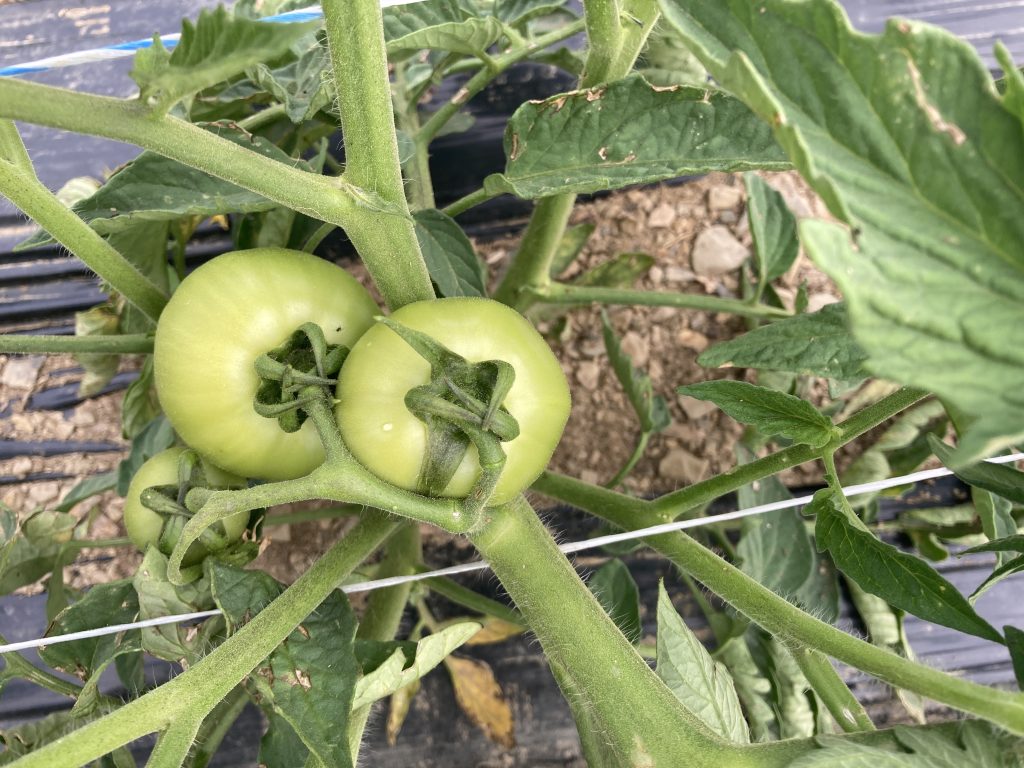
A few rows over, I checked on my eggplants under their row covers, which are beginning to flower. Soon the baby eggplant will begin growing from the flower buds.
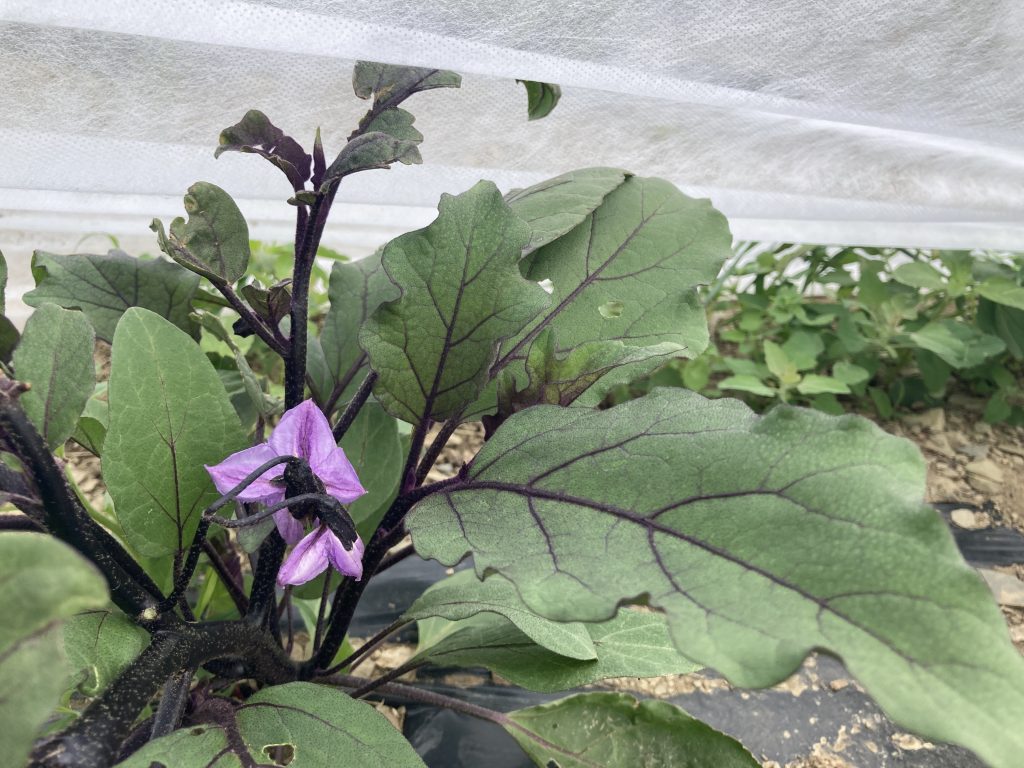
That’s not all… the young teens scored a sitting job today in order to make sure that we don’t run out of vegetables this fall. The farm girls taught their California cousin how to plant new seeds so we will have cauliflower, broccoli and cabbage for you this fall. I’m proud of everything my nephew is learning and proving he can work hard while he visits the farm.

The process of packing your Market Boxes is pretty intense but you can hardly tell how much concentration it takes to get every item correct. Our Pack Team makes it look easy and effortless in this Behind the Scenes Video.
You might wonder what I’m doing while I manage all this activity. You can usually find me on my phone answering questions and I’ll jump into to help the pack team by refilling the veggie bins for them to keep them working fast and efficiently.
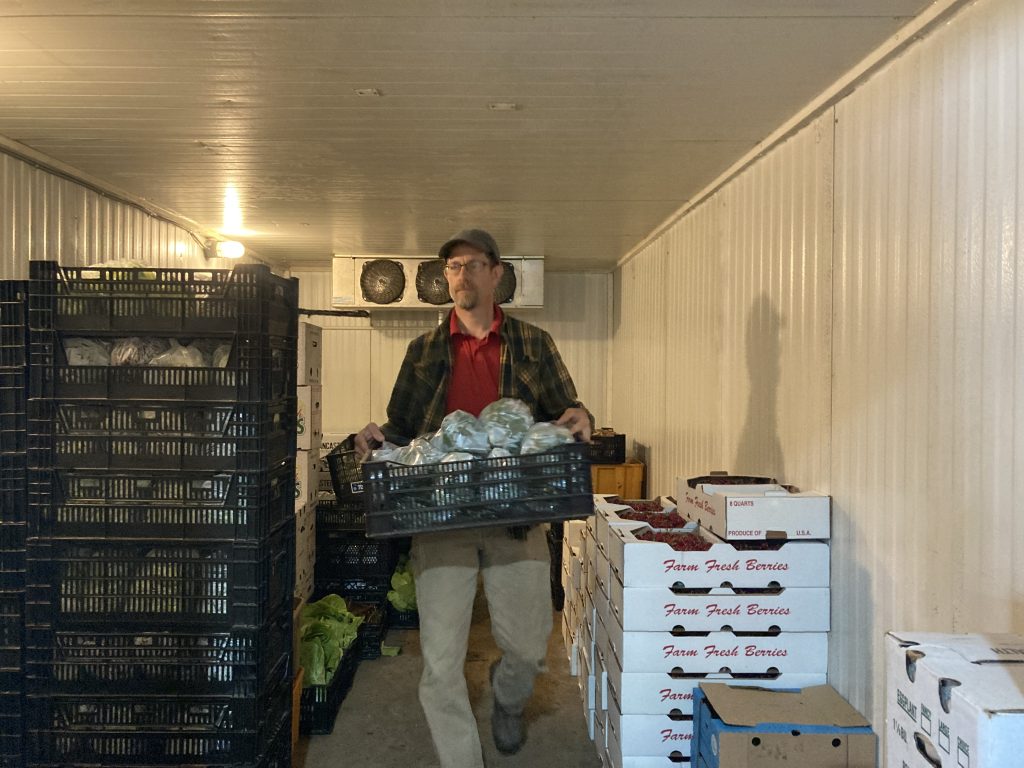
Bonus Trivia:  Did you know our delivery van is a mobile, refrigerated cooler? When it’s not driving around we can plug it in to keep the refrigeration running so your farm food stays fresh and cool.
Did you know our delivery van is a mobile, refrigerated cooler? When it’s not driving around we can plug it in to keep the refrigeration running so your farm food stays fresh and cool.
We’ll keep farming for you!
Reuben and Tessa DeMaster
Willow Haven Farm
Don’t Miss Your Farm Events:
First Ever FRIDAY Pizza Night on the Deck
Friday June 30. 5 – 8 pm.
Details Here!
Don’t miss it!
Market Box Value!
Five of our Top Tips to get the most value out of your Market Box and enjoy the most food you’ll love. Read Here.
Your List of What to Return:
Please return the packaging we sent you for your last delivery. Here’s how and what exactly we’ll take back: Read Here.
We’ll Keep Farming for You!

